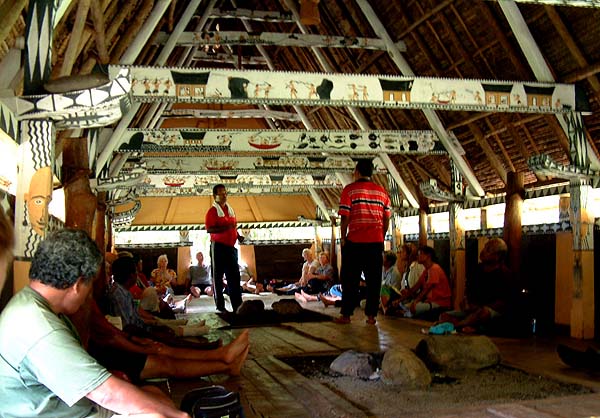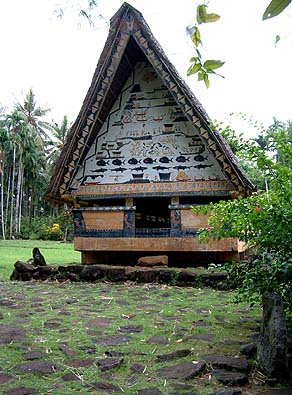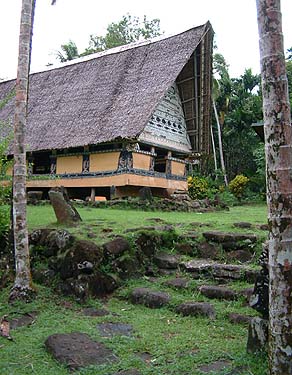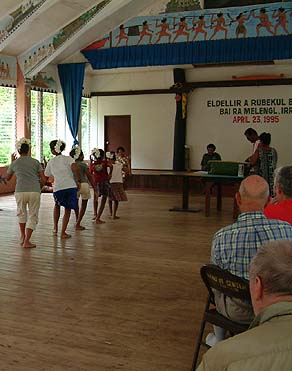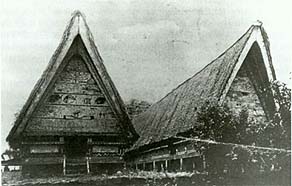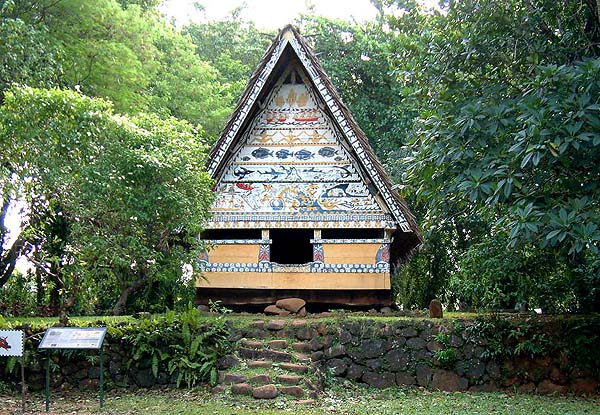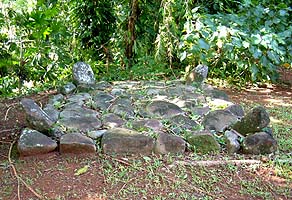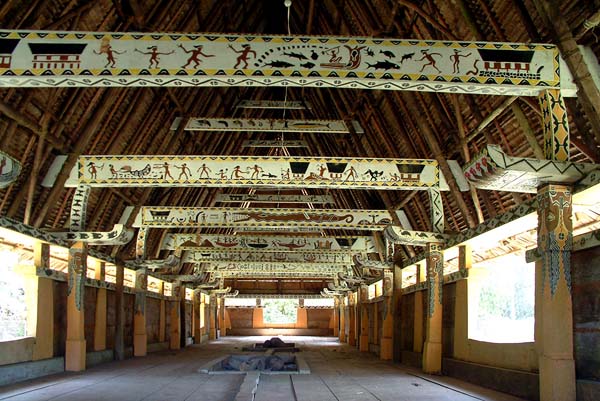 |
 |
 |
 |
||||
|
|
|
|
|
|
|
|
|
|
|
|||||||
|
|
|
|
The rubak of Airai Village narrate a tale from a tie beam for a cultural tourism group.
|
|
There are many sacred sites in a village. “You can’t see them,” Walter says. “You just go over there and ask them, if there are people in the village, they know where the sacred places are. In all the villages, you have to go talk to the people in the village who know. "Our Cultural Affairs office doesn’t determine them—it has to be from the villagers, saying that it is sacred, and then we will accept it. That’s because we don’t know, we cannot declare that something is sacred, unless they tell us about the sacredness of it."
|
||
|
|
||
“The rubak’s bai, the bai for the elder chiefs, is like a sacred site. The kids today don’t know, but if you were growing up with all those older people, and you saw the bai and how the rubak were gathered, and how the people in the community regarded them.…You can’t feel that now. These days, the new generations are seeing it as a community museum, where you see a lot of art. "But the rubak’s bai: you go to any village, old village, and if you study how the village is laid out, there are sort of like a back roads for going around the bai. You don’t go in front of the bai when the rubak are in it. You just don’t do it."
|
|
|
“In a sense, to some extent a bai is sacred,” Tina adds, “because traditionally they’re used for functions dictated by the council of chiefs. And so there were certain traditional protocols that had to be adhered to. So in a sense it is very sacred. "Like for example in Airai Village, and I am sure that the chiefs in Airai have probably told you about, but normally you just don’t got there and go inside the bai. Today, in this day and age, when they invite you to go in to give a talk or to discuss something, then you go in. "Otherwise, you don’t just go in. There are certain protocols. They have their own permission process that they do, and only those chiefs there would have the say on that."
|
|
|
|
Interior of the Bairairrai.
|
“When bai are not occupied,” Johnson says, “somehow they become too squeaky, and they age faster. Since I became Ngiraked, I made up my mind that we have to meet once a month, at least, at our traditional meeting place, the Bairairrai, to make it livable. It is I think the last remaining bai in Palau—authentic one. It has been replaced several times but that is the real seat of the Airai Village council of chiefs, who lived there. I don’t like to meet in other places, because I think this is part of the tradition. "So we made a point to meet here at least one a month. And when cultural tourists come, we meet with them. We like to share.”
|
||
|
|
||
“There were times when we went to the bai in Airai Village as part of an event,” says Tina. “Once was part of the Pacific Islands Music Association, with representatives from many Pacific Islands. There was a conference workshop here and there was a session that we held a over at the bai, using that as a traditional bai. "First we came here, and then also we went there. Because it was a museum workshop conference, they allowed us in and we gathered there, and they gave us their discussion about the structure of the bai and council of chiefs as well. "So the sacredness to it is adhered to by those people there, and of course you have to respect that.”
|
|
|
“There are modern-built bai in Melekeok, Aimeliik, and the one in Koror by the museum,” Walter says. “That is like a modern bai for the convenience or the visitors: they come over there and see and then they just come. The Bairairraiis a real cultural, traditional bai. "In Koror, that is not where the bai is supposed to be. They built it there, but the bai that were in Koror, the main bai were where they have the Koror state office now. There were three bai over there for the village of Koror, but not in that part of that area, not where the location is now.”
|
|
|
|
|
“The bai here at the museum is in a sense is not a traditional village bai,” Tina explains. “We could say it is a ‘national bai,’ as it was built for the purpose of being part of meetings. It is used for different functions—from young people to adults using it for various activities, ranging from classes to workshops to conferences, to as a show place. We also use it to teach the children about the bai. The storyboards here are pan-Palauan. Since this is a national building, built for the whole Palau, it has stories from all different villages."
|
||
|
|
||
“But it is not used not as a traditional bai, in the traditional protocol like in Airai. Nor is it located on a traditional bai site. It is part of the national museum complex. This bai was built by local people, built and painted. That knowledge is still here. “Those in Melekeok and Aimeliik are traditional bai on their traditional sites, and are used by the rubak or the chiefs there. It is a very traditional. They are very much like Airai: they are built on original sites, stone platforms, all of that. But they are much more recent than the one in Airai. The Airai one is the oldest."
|
|
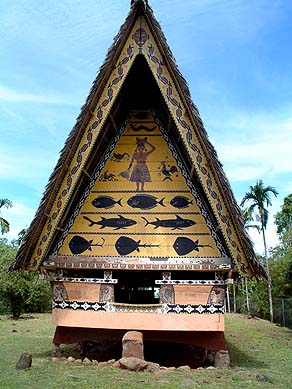
|
“I think recreating the bai in Aimeliik and Melekeok is an important part of the continuity of our culture, and the knowledge and skills of people of those villages. That way you maintain and preserve the art of building, the art of storytelling, the art of carving, the art of painting. The Palauans were painters as well as carvers, as they painted the bai, using the traditional coloring system. "Since Melekeok and Aimeliik built their bai, there probably will be other villages where the traditional council would follow suit eventually. I’ve heard some villages talking about it, so there’s a likelihood that more villages will build their own traditional bai. “I know of at least three people who know how to do all the measurements and so forth to build a bai. They are in their 50's. There is also a person that has written a booklet about the bai, with the measurements, the names of the measuring system in Palauan, the parts and the designs, and so forth. These terms are preserved by just writing a book about the bai. "
|
| |
|
Interior of the bai at Aimeliik.
|
|||
|
|
|
|
|
|
|
|
|
|
|||
| “There were years and years when bai were just sort of destroyed, and then especially WWII when they were all destroyed. So the building of the bai is in a way to reaffirm—to reaffirm the knowledge and say, ‘yes, we can still do this'." With these thoughts, we turn to depart Airai.
|
||
|
|
||
|
|
|
|
|
|

|
| Airai Home | Map Library | Site Map | Pacific Worlds Home |
|
|
|
|

|
|
|
|||
| Copyright 2003 Pacific Worlds & Associates • Usage Policy • Webmaster |
|||
